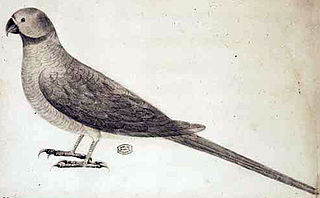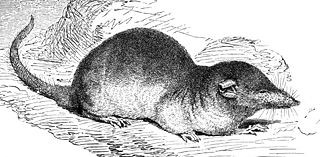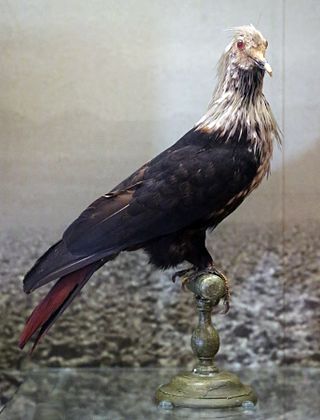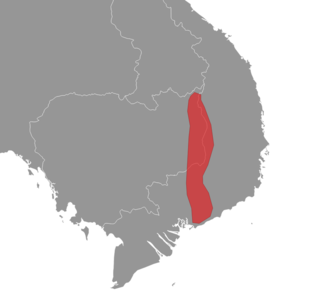
Shrews are small mole-like mammals classified in the order Eulipotyphla. True shrews are not to be confused with treeshrews, otter shrews, elephant shrews, West Indies shrews, or marsupial shrews, which belong to different families or orders.

Newton's parakeet, also known as the Rodrigues parakeet or Rodrigues ring-necked parakeet, is an extinct species of parrot that was endemic to the Mascarene island of Rodrigues in the western Indian Ocean. Several of its features diverged from related species, indicating long-term isolation on Rodrigues and subsequent adaptation. The rose-ringed parakeet of the same genus is a close relative and probable ancestor. Newton's parakeet may itself have been ancestral to the endemic parakeets of nearby Mauritius and Réunion.

The white-toothed shrews or Crocidurinae are one of three subfamilies of the shrew family Soricidae.

Pierre Sonnerat was a French naturalist, colonial administrator, writer and explorer. He described numerous species of plants and animals on his travels and is honoured in the genus Sonneratia and in other specific names such as that of the grey junglefowl Gallus sonneratii.

The piebald shrew is a shrew found in the Turan Lowland east of the Caspian Sea in Iran, Turkmenistan and Uzbekistan.

The Seychelles parakeet or Seychelles Island parrot is an extinct species of parrot that was endemic to the Seychelles in the Indian Ocean. It was scientifically named Palaeornis wardi by the British ornithologist Edward Newton in 1867, and the specific name honours the British civil commissioner Swinburne Ward who procured the specimens that formed the basis for the description. It was found on the islands of Mahé, Silhouette, and possibly Praslin. Ten skin specimens exist today, but no skeletons. Though the species was later moved to the genus Psittacula, genetic studies have led some researchers to suggest it should belong in a reinstated Palaeornis along with the closely related Alexandrine parakeet (P. eupatria) of Asia.

The genus Crocidura is one of nine genera of the shrew subfamily Crocidurinae. Members of the genus are commonly called white-toothed shrews or musk shrews, although both also apply to all of the species in the subfamily. With over 180 species, Crocidura contains the most species of any mammal genus. The name Crocidura means "woolly tail", because the tail of Crocidura species are covered in short hairs interspersed with longer ones.

The Mauritius blue pigeon is an extinct species of blue pigeon formerly endemic to the Mascarene island of Mauritius in the Indian Ocean east of Madagascar. It has two extinct relatives from the Mascarenes and three extant ones from other islands. It is the type species of the genus of blue pigeons, Alectroenas. It had white hackles around the head, neck and breast and blue plumage on the body, and it was red on the tail and the bare parts of the head. These colours were thought similar to those of the Dutch flag, a resemblance reflected in its French common name, Pigeon Hollandais. The juveniles may have been partially green. It was 30 cm (12 in) long and larger and more robust than any other blue pigeon species. It fed on fruits, nuts, and molluscs, and was once widespread in the forests of Mauritius.

Diplomesodon is a genus of shrew that contains a single extant species, the piebald shrew (Diplomesodon pulchellus).

The Cretan shrew is a species of mammal in the family Soricidae. It is endemic to the island of Crete, Greece. Its natural habitat is temperate shrubland, and the animal is threatened by habitat loss. It is found in the mountainous highlands of Crete, having been displaced from lower altitudes by the lesser white-toothed shrew.

Crocidura hikmiya is a species of shrew described from the rainforests of Sri Lanka, based on both morphological and molecular data. Its closest sister species is the Sri Lankan long-tailed shrew, another Sri Lankan crocidurine shrew restricted to the high-elevation habitats of the Central Highlands. C. hikmiya has a shorter tail than the Sri Lankan long-tailed shrew. Most of the other characteristics that distinguish the two species are osteological natured .

Crocidura phanluongi is a species of shrew in the genus Crocidura from southern Vietnam and nearby Cambodia. It is a somewhat small, gray shrew with an ecologically diverse distribution.

The Panay shrew is a species of shrew from the Philippines.

The Batak shrew is a species of shrew from the Philippines.

Crocidura sapaensis is a species of white-toothed shrew native to northern Vietnam. It was first described in 2013 and its specific name derives from the Sa Pa where it was discovered.
The Sanetti shrew or Bekele's shrew is a species of mammal in the family Soricidae. It is endemic to Ethiopia.
The Fingui white-toothed shrew or Principe white-toothed shrew is a species of mammal in the family Soricidae. It is endemic to the island of Príncipe in São Tomé and Príncipe.
The Lwiro shrew or Misotshi-Kabogo shrew is a species of mammal in the family Soricidae. It is endemic to the Democratic Republic of the Congo.
The Dracula shrew, also known as the large white-toothed shrew, is a species of mammal in the family Soricidae. It is found in Vietnam, Laos, and adjacent southern China, with possible range extension into Cambodia east of the Mekong River. Because it is so visually similar to the Southeast Asian shrew, it has historically been considered part of the same species complex and the range delineation between the two species is still being resolved. Recent genetic evidence strongly supports that the Dracula shrew is in fact a uniquely diverged species.
Sokolov's shrew is a species of mammal in the family Soricidae. It is endemic to Vietnam.















